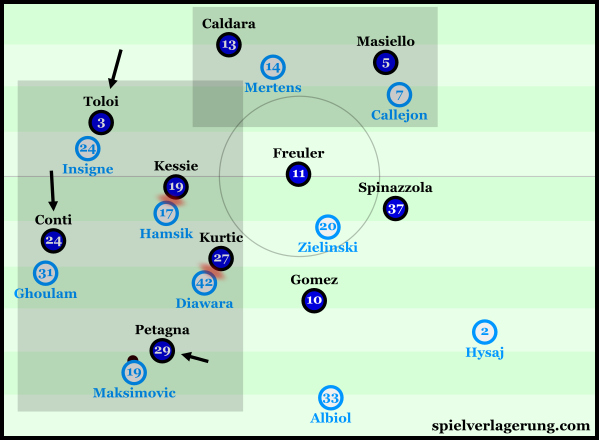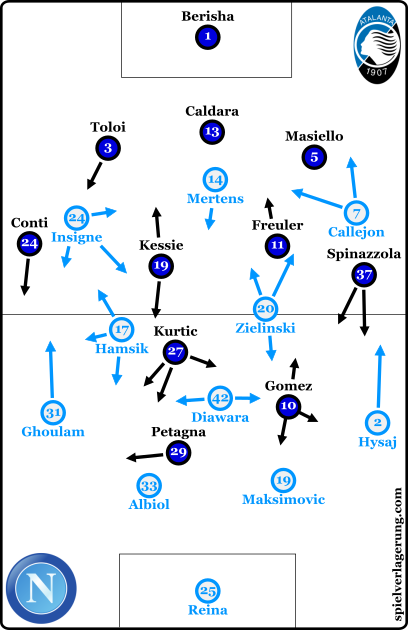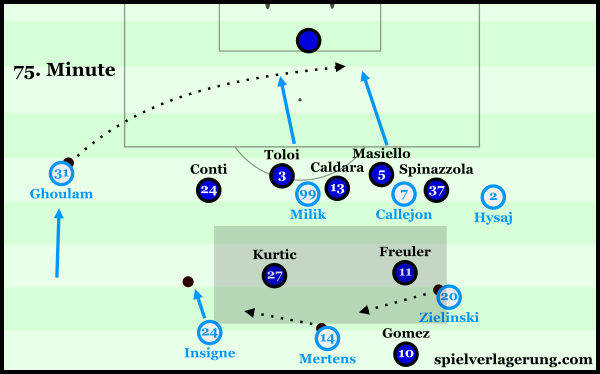Atalanta shutdown Napoli attack with pressing Game
Atalanta continued their excellent season last night with a surprise win over Napoli. Their pressing was key in restricting their hosts’ excellent left side, which helped to reduce the dynamic of their attacks.
Atalanta Stifle Napoli’s Left
A key feature of Napoli’s build-up is their focus on combining through the left side of their structure. This area hosts some of their most dynamic players in Hamsik and Insigne, and the resulting combinations and attacks mirror this. Therefore, it’s crucial to limit their ability to form attacks down this side, which Atalanta looked to achieve through their pressing game.
They did so in a man-to-man fashion with a reactive shape, yet one suitable to match up with Napoli. Conti would move up and press Ghoulam while Petagna moved wide to close down Albiol. Kurtic and Kessie were both in strong starting positions to press Diawara and Hamsik individually, while Toloi moved out of the back three to cover Insigne.
While such a reactive defensive strategy could be vulnerable against a team such as Napoli, who have high individual and collective pressing-resistance, Atalanta were successful in their approach. The intensity of their tracking movements was important, helping them to maintain access despite the movement of Napoli which hoped to disorganise their structure. It also forced a side that is typically calm under pressure into a number of misguided passes, throwing Napoli off of their game especially in the beginning of the match.

Atalanta’s man-oriented pressure on Napoli’s left-sided build-up. Error – Maksimovic and Albiol depicted the wrong way around.
Probably due to fitness reasons, the intensity was slightly reduced after the first 30 minutes. The influence of their pressing early on was important however, as it gave them early superiority over their opponents and stopped them creating any chances up until the 38th minute.
Napoli Adjust Build-Up
Due to the visitors’ pressure, Napoli were forced into less familiar means of progression into midfield. They still intended to build-up through their left, but instead would start from a more central position then hit the ball diagonally to Ghoulam on the touchline, who would have more space to utilise. Yet in these scenes, they struggled to combine with any momentum from Ghoulam. Hamsik and Insigne had narrower starting positions and weren’t always connected to their left-back once he received the pass. Therefore, Atalanta could usually re-adjust in time and avoid being caught out.
If they were to build through the left, Napoli were more effective if Diawara had a greater presence, or Hamsik was positioned slightly wider in the shape. Doing so allowed them to overload Atalanta’s press, who were at times reluctant to follow their man so far away from their original position, while gave them more individual pressing resistance through both midfielders’ technical qualities. Yet Napoli didn’t use this regularly, especially through the first 20 minutes where they struggled to develop any great bouts of possession.
Instead, right-back Hysaj saw the ball in deeper areas than he is accustomed to, as Napoli’s right-side is typically more direct, often receiving switches following a build-up on the opposite flank. Their spacing during these moments was quite ineffective for progression, perhaps due to the player-profiles fitting these positions. Jose Callejon is capable of world-class off the ball movements in more advanced zones, but isn’t as natural when dropping in and combining to bring the ball forwards. Zielinski is suited to such a task, but couldn’t evade the defensive coverage enough to engage in the build-up consistently. The trio were more potent higher up the pitch, yet in build-up they struggled to advance the ball down the flank.
Napoli’s best chance of the first half came when Hysaj received the ball in a more advanced area. The Albanian was allowed to carry the ball forwards due to Atalanta’s defence losing its orientation with Hamsik moving across into the right half-space, with Kessie unwilling to follow. In this position, the right-back was able to display his better passing in more advanced zones, with an excellent pass to pick out Mertens in a central position.
As the first half progressed, Lorenzo Insigne increasingly became more free off the ball, and would move far away from his left half-space to influence possession. Toloi covered the forward closely in their local half-space, and challenged him well from behind every time he received a ball, in particular timing his press to prevent Insigne from turning cleanly. But if Insigne drifted more centrally, then the centre-back was understandably reluctant to follow him, and he could enjoy some space as the free-man.
They rarely threatened from such situations, and often struggled to break through the last line of defence. All three Atalanta centerbacks can be credited with impressive performances, supported by the presence of a third member.
Diagonal Attacks Struggle
When they did progress down the left, Napoli failed to diagonally bring the ball back inside as they usually do. In a typical performance, they’re capable of combining the ball quickly back inside towards goal through Insigne and Hamsik, or more directly switching towards Callejon on the opposite side. Yet against Atalanta, Sarri’s team were unable to form a dangerous attack until late in the first half.
The movements of the forwards weren’t coordinated well in these moments, with Hamsik not being as influential higher up in the left half-space. This particular issue could be a result of the star’s responsibility to help build-up more against Atalanta’s pressure, resulting in a deeper position when it was time to attack directly towards goal. The half-space link between the ‘build-up’ and ‘attack’ moments was often missing, making the home side resort to uncontrolled direct passes which were rarely effective.
Credit must also be given to the Atalanta defensive-line, who all anticipated any attacking passes well. Toloi and Caldara were particularly vigilant in blocking any attempts to penetrate the penalty area, albeit doing a job made easier by an off-day from their opponents.
Napoli Improve for the Second Half
Napoli followed up their disappointing first half with an improved showing after the interval. Almost straight away they showed greater pressing-resistance and used simple combinations involving Hamsik and Zielinski to open up more advanced spaces on the flanks. Their improvements could be attributed to simply better individual performances, as Napoli were systemically similar and attempting similar combination patterns, but with better and more consistently-accurate actions.
There were some slight changes, which could have aided this improvement too, however. One interesting note was that Ghoulam began to move into the left half-space at times, while Insigne would balance through a wider positioning. This could have been to disrupt Atalanta’s man-oriented defence, as Conti didn’t follow his man inside which left Kessie with two men to deal with at times. This action allowed Napoli to progress through the left, as Ghoulam would receive the ball in higher positions with Kessie focused on Hamsik and Insigne occupying the wide defender. Their attacking movements were also better timed, with the front three working better to open up gaps in the opponents’ defensive line.
Considering Napoli’s increasingly-promising performance, the substitution of Hamsik for Milik was a confusing one and, in my opinion, a step backwards from the home side. They were slowly become more fluent with the ball and by withdrawing such an important player in their attack, their progress haltered. I’m sure Sarri had a sound reasoning behind his decision, though I’m unable to confidently put my finger on it.
Napoli Dominate After the Red Card
Atalanta made a shift to a 5-2-1-1 following Kessie’s dismissal, yet just minutes later they were two up after Caldara started and ended a counter-attack with an excellent finish. The tactical change was fairly simple, with Kurtic dropping to a RCM position with Gomez playing slightly deeper in defence. But with only two in midfield, they were vulnerable during Napoli possession, and especially so against horizontal switches of play, due to their inability to cover the width of the pitch. Sarri’s team looked to use this tactic as a means of creating space, and did so fairly well – in once case creating Callejon’s point-blank header miss.
With under ten minutes to spare, Atalanta made a change of shape to strengthen their midfield line, adding Grassi in place of Gomez, thus changing to a 5-3-1. Importantly, Grassi joined the right side of the midfield, which could have been to specifically protect the right-to-left switches, where Napoli looked to give space to Mertens (who was now on the left of the attack) and Ghoulam. In the even of such a switch, the fresh addition could quickly move out to challenge the pass to the wide player.
https://twitter.com/11tegen11/status/835575451166859264
Despite their dominance since the red card (67’), Napoli failed to create a lot of high-quality chances. Especially for the last ten, they were very cross-heavy with many from bad (particularly deep) locations. Expected goals suggests they could be considered unfortunate to not have scored one in the second half, yet they wasted their superiority to some extent with inefficient attacking strategies later on.
Conclusion
Atalanta made an excellent defensive performance with their man-oriented pressure helping to blunt one of the most dynamic and synergistic flanks in football. Despite worries in the second half and after the red card, Gasperini’s side held on and were slightly fortunate to keep a clean sheet. The coach’s change to a three-man midfield was helpful to ensure victory, while Napoli made a weak end to the game. Sarri’s side looked little like their usual selves, and although their opponent deserves credit for this, their issues were somewhat self-inflicted.





1 Kommentar Alle anzeigen
Zlatan February 27, 2017 um 10:31 am
Hysaj Swedish? I wish! 🙂